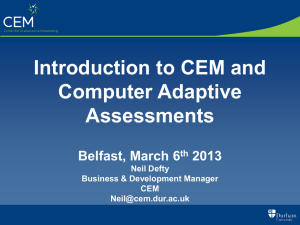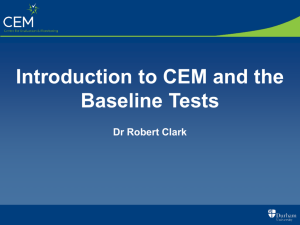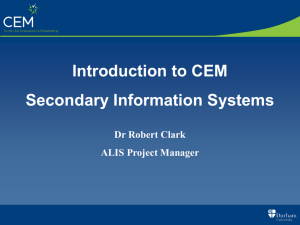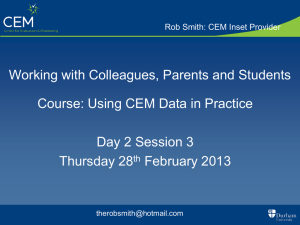Computer Adaptive Baseline Test
advertisement
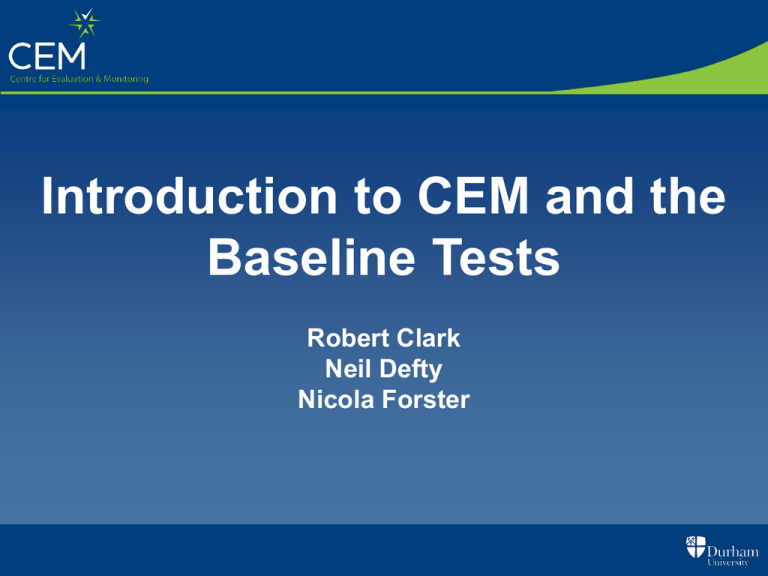
Introduction to CEM and the Baseline Tests Robert Clark Neil Defty Nicola Forster Who / What is CEM ? Centre for Evaluation & Monitoring • • • • • • • • • Not for Profit Organisation Part of Durham University Close links to School of Education Established 1985 Nursery / Reception Post-16 Monitoring Systems, Research and Evaluation Projects UK & International Over 1/3 Secondary & Post-16 Establishments Informed by Evidence from Research The Systems The Systems A / AS / Btec / IB etc Year 13 Year 12 Alis GCSE Computer Adaptive Baseline Test GCSE KS3 Year 11 Yellis Year 10 Computer Adaptive Baseline Test INSIGHT Year 9 Year 8 Year 7 Combines curriculum tests with developed ability MidYIS Computer Adaptive Baseline Test Typical Timeline Typical Timeline Early Testing & Predictions START: Measure Baseline Autumn Term Feedback Reports A ugust END: September Collect and Send Results Value-Added Feedback Testing is available from June at end of previous academic year e.g. Y6 / Y9 / Y11 The baseline score is measured as early as possible and the information sent to CEM The institution then receives feedback from CEM: baseline test results and predictions The public examination results are sent to CEM when received by the institution The value added data is available from September via the Institution’s website at CEM Baseline Assessments of Developed Ability Baseline Assessment • • • • Year 7 (8) Year 9 Year 10 (11) Year 12 (13+) Computer Adaptive Baseline Test Vocab Maths Non Verbal What is an Adaptive test ? • All questions allocated to groups of different difficulty • All students in a year group get common difficulty starting question • If answer correct, next question harder • If answer wrong, next question easier • Test looks at all answers in a section and homes in on questions of a suitable difficulty for student Try it yourself at www.intuproject.org/demos X Standardisation • Test scores are standardised; Mean = 100, SD = 15 Standardised Score National Percentage Comment >130 Top 2.5% Traditional classification of ‘mentally gifted’ >120 Top 10% >100 Top 50% <80 Bottom 10% <70 Bottom 2.5% Potential special educational needs ?? The Computer Adaptive Baseline Test: • Adaptive components common to MidYIS, Yellis, and Alis are: – – Vocabulary Maths • Non- adaptive sections: – – Non-verbal (MidYIS, Yellis, Alis) Skills (MidYIS only) • Assessments are ‘curriculum free’: i.e. students are not taught prior to the test • Measure of acquired ability • There is no preparation for the test Difficult vocabulary Difficult maths Non-Verbal: Cross-sections Non-Verbal: Blocks Non-Verbal: Pictures Pictures Skills: Proof Reading Skills: Perceptual Speed and Accuracy INSIGHT Curriculum-based assessments covering: Maths - Number & Algebra - Handling Data - Space, Shape & Measurement Science - Biology, Chemistry, Physics, - Attitudes to Science Reading - Speed Reading - Text Comprehension - Passage Comprehension Additionally for INSIGHT: Developed Ability • Vocabulary • Non verbal, Skills • Attitudinal measures INSIGHT - Maths INSIGHT - Maths INSIGHT - Science Plus Attitude to Science: Perception of Science, Relevance to Self, Environmental Actions, Enjoyment of Science INSIGHT – Reading (Text Comprehension) INSIGHT – Reading (Passage Comprehension) INSIGHT – Reading (Speed Reading) INSIGHT – Developed Ability Measuring Ability Key Stage Data or Baseline Test ? Key Stage Baselines – KS2; GCSE Strengths Weaknesses Related to curriculum Dependent on teaching effectiveness (prior ValueAdded) as well as student ability Automatically available Open to manipulation In Depth Not all students have KS data Linked to student learning experience Reliability of KS measure Consistency of KS score (i.e. GCSE & Btec First etc) Independent Baseline Test – CEM Adaptive Test The Effect of Prior Value Added Beyond Expectation In line with Expectation Below Expectation +ve Value-Added 0 Value-Added -ve Value-Added Average GCSE = 6 Average GCSE = 6 Average GCSE = 6 Do these 3 students all have the same ability ? Baseline Feedback Feedback from Baseline Test • Intake Profiles • Individual Pupil Records (IPRs) • Predictions & Chances Graphs Individual Pupil Record Sheets (IPRs) Look for sections that are inconsistent Available in all systems pre & post 16 Predictions . How CEM ‘Predictions’ are made… Subject Subject X X Outcome 140 A* / A120 100 C 80 60 40 20 0 04 25 46 67 8 Baseline Regression Line (…Trend Line, Line of Best Fit) Outcome = gradient x baseline + intercept Correlation Coefficient (~ 0.7) Some Subjects are More Equal than Others…. 140 A* A Grade 120 B 100 >1 grade Photography Sociology English Lit Psychology Maths Physics Latin 80 C 60 D E 40 5 C 6 B A7 Average GCSE A*8 Some Subjects are More Equal than Others…. GCSE (MidYIS or Yellis) A* A GCSE Grades B 1 grade C D E F Test Score Art & Design Biology Chemistry Economics English French Geography German History Ict Mathematics Media Studies Music Physical Education Physics Religious Studies Science (Double) Spanish Predictions – MidYIS example Similar spreadsheets available from Yellis & INSIGHT Individual Chances Graph for Student no.5 - GCSE English MidYIS Score 82 MidYIS Band D 40 33 35 Prediction/expected grade: 3.8 grade D Percent 30 23 25 23 Most likely grade 20 15 10 10 5 2 5 3 1 0 A A* 0 U G F E D Grade C B Predictions - Alis example Why KS Baselines do not always tell the whole story Student 1 Student 2 Student 2 - IPR Student 3 Student 3 - IPR Vocab Item Responses Correct 30 Response Time (s) 25 20 15 10 5 0 1 2 3 4 5 6 7 8 9 10 11 12 13 14 15 16 17 18 19 20 21 22 23 24 25 26 27 28 29 30 31 32 33 Question Wrong Thank You Robert Clark – robert.clark@cem.dur.ac.uk Neil Defty – neil.defty@cem.dur.ac.uk Nicola Forster – nicola.forster@cem.dur.ac.uk
